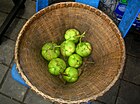Note: This is a project under development. The articles on this wiki are just being initiated and broadly incomplete. You can Help creating new pages.
Dillenia indica - Bhavya
Bhavya Elephant apple is a very ornamental evergreen tree with a rounded crown and large corrugated leaves that can grow up to 30 metres tall, though is usually smaller. The bole can be 120cm in diameter, often branching from low down. The plant provides an edible fruit, polish, soap and medicines for the local people.
Contents
[hide]- 1 Uses
- 2 Parts Used
- 3 Chemical Composition
- 4 Common names
- 5 Properties
- 6 Habit
- 7 Identification
- 8 List of Ayurvedic medicine in which the herb is used
- 9 Where to get the saplings
- 10 Mode of Propagation
- 11 How to plant/cultivate
- 12 Commonly seen growing in areas
- 13 Photo Gallery
- 14 References
- 15 External Links
Uses
Cough, Bad breath, Improves digestion[1]
Parts Used
Chemical Composition
Stem bark of D. indica contains 10% Tannin, Dillenetin, Betunaldehyde, Betulinic acid, Flavonoids like Rhamnetin, Dihydro Isorhamnetin, Lupeol, Myricetin, Naringenin, Quercetin derivatives and Kaempferol glucoside etc.[2]
Common names
| Language | Common name |
|---|---|
| Kannada | Bettakanagalu, Kal tega, Naaythaeku |
| Hindi | Chalta, Girnar |
| Malayalam | Punna, Syalita, Valappunna, Valapunna, Vazchapunnai |
| Tamil | Uvatteku, Uvav, Kattarali, Kurukati |
| Telugu | Kalinga, Muchiru, Peda kalinga, Revadi chettu, Uppu ponna, uva |
| Marathi | NA |
| Gujarathi | NA |
| Punjabi | NA |
| Kashmiri | NA |
| Sanskrit | Bhavya, Bhavyam, Ruvya, Picchila beeja |
| English | Elephant apple |
Properties
Reference: Dravya - Substance, Rasa - Taste, Guna - Qualities, Veerya - Potency, Vipaka - Post-digesion effect, Karma - Pharmacological activity, Prabhava - Therepeutics.
Dravya
Rasa
Madhura (Sweet), Amla (Sour), Kashaya (Astringent)
Guna
Guru(Heavy), Picchila (Slimy)
Veerya
Sheeta (cold)
Vipaka
Madhura (Sweet)
Karma
Vata
Prabhava
Habit
Identification
Leaf
| Kind | Shape | Feature |
|---|---|---|
| Simple | Alternate | Petiole 15-75 mm long, stout, sheathing, winged, tomentose, grooved above; lamina 18.5-30 × 5-10 cm, elliptic. |
Flower
| Type | Size | Color and composition | Stamen | More information |
|---|---|---|---|---|
| Bisexual | Terminal | White | 12-15 cm across, solitary, white, terminal; pedicel 4-8 cm long. Flowering from June to November |
Fruit
| Type | Size | Mass | Appearance | Seeds | More information |
|---|---|---|---|---|---|
| Aggregate of berries | 3.5 × 1.5 cm | Globular, covered by overlapping circular scales | Seeds 5, 6×4 mm, reniform, compressed | Fruiting from January to March |
Other features
List of Ayurvedic medicine in which the herb is used
Where to get the saplings
Mode of Propagation
How to plant/cultivate
Can be easily grown from seeds, but seeds have a short viability.
Commonly seen growing in areas
Tropical area, Sub tropical area
Photo Gallery
References
- ↑ Jump up to: 1.0 1.1 "Karnataka Medicinal Plants Volume - 2" by Dr.M. R. Gurudeva, Page No.481, Published by Divyachandra Prakashana, #45, Paapannana Tota, 1st Main road, Basaveshwara Nagara, Bengaluru.
- Jump up ↑ Chemical Constituents
- Jump up ↑ Vernacular names
- Jump up ↑ Botanic Description
External Links
- Ayurvedic Herbs known to be helpful to treat Cough
- Ayurvedic Herbs known to be helpful to treat Bad breath
- Ayurvedic Herbs known to be helpful to treat Improves digestion
- Herbs with Fruits used in medicine
- Herbs with common name in Kannada
- Herbs with common name in Hindi
- Herbs with common name in Malayalam
- Herbs with common name in Tamil
- Herbs with common name in Telugu
- Herbs with common name in Sanskrit
- Herbs with common name in English
- Habit - Tree
- Index of Plants which can be propagated by Seeds
- Index of Plants which can be propagated by Cuttings
- Herbs that are commonly seen in the region of Tropical area
- Herbs that are commonly seen in the region of Sub tropical area
- Herbs
- Plants of western ghats
- Dilleniaceae
- Ayurvedic herbs that don't have seed photos






